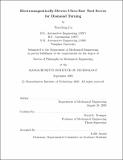Electromagnetically-driven ultra-fast tool servos for diamond turning
Author(s)
Lu, Xiaodong, Ph. D. Massachusetts Institute of Technology
DownloadFull printable version (23.86Mb)
Other Contributors
Massachusetts Institute of Technology. Dept. of Mechanical Engineering.
Advisor
David L. Trumper.
Terms of use
Metadata
Show full item recordAbstract
This thesis presents the design, implementation, and control of a new class of fast tool servos (FTS). The primary thesis contributions include the design and experimental demonstration of: novel ultra-fast electromagnetic actuators, integration of these actuators in a new class of FTS, a novel real-time control computer with 1 million samples per second throughput, MIMO loop shaping techniques for parallel power amplifiers, and a novel configuration and controller tuning method for implementing adaptive feed-forward cancellation control. All of these elements have been successfully used for diamond turning of contoured surfaces. Fast tool servos (FTS) are high bandwidth positioning devices, which, in conjunction with an ultra-precision lathe and diamond tooling, can produce free form surfaces with nanometer-scale resolution, such as required in micro-optical devices and light-enhancing films. The increasing complexity of such surfaces requires more components in shorter spatial wavelengths, and thus drives simultaneously the need for high bandwidth, high acceleration and high accuracy of the FTS. Conventional FTS solutions are based on piezoelectric stacks, which are typically limited to a few micron stroke at 1 kHz operation if not operated in a resonant mode. (cont.) As a promising alternative, this thesis demonstrates electromagnetically driven solutions for fast tool servos. The key new technology in these alternative designs is a new class of ultra fast electromagnetic drivers with thousands of G's acceleration capability in continuous operation. By separating the flux-biasing surfaces from the normal-flux working surfaces, this new driver design has a number of advantages: (1) actuating force linear to both excitation current and displacement, (2) modularity and parallel operating ability, (3) full magnetic stress utilization of normal surfaces, and (4) low heat dissipation. We analyze the operation characteristics, and also provide soft magnetic material selection criteria and motor design guidelines. Based on this ultra fast driver, we designed a linear fast tool servo with the theoretical capability for 1200 G acceleration in continuous operation. To control such positioning devices at bandwidth of over 10 kHz, we developed a real-time computer architecture, utilizing three floating point digital signal processors (DSPs) in conjunction with a field-programmable gate array (FPGA) to significantly increase the processing rate. (cont.) The real-time computer prototype experimentally demonstrated 1 million samples per second real-time control execution with a total latency of 1.9 microseconds when implementing a representative control algorithm of significant complexity. This processing system has capabilities far beyond what is commercially available for such real-time high-accuracy control tasks. The power amplifier driving the FTS must supply 1 kVA (primarily reactive power) with over 100 kHz bandwidth. We present a solution of using 4 power operational amplifiers in parallel, each capable of supplying one fourth of the total power. To address the coupling issues among channels, a decoupling theory is developed to convert the associated MIMO plant into several SISO sub-plants, and thus ease the analog decentralized controller design of the power amplifier current feedback loops. In order to enhance the FTS repetitive position trajectory tracking and disturbance rejection, adaptive feed-forward cancellation is embedded into a conventional motion control loop in our system. We provide a consistent loop shaping framework and intuitive parameter tuning and trade-off guidelines for this controller structure. (cont.) Experimental results with the first prototype FTS using powder iron cores demonstrate 23 kHz closed-loop bandwidth, as low as 1.7 nm RMS error, 30 micron stroke, 500 G peak acceleration at 10 kHz open-loop operation, and 2.1 nm (0.04%) error in tracking a 3 kHz sinusoid of 16 micron p-v. (The full 1200 G capability is expected to be experimentally demonstrated by the second prototype FTS using Ni-Fe tape cores). Using this FTS, we have diamond-turned two-dimensional sinusoidal surfaces in copper and aluminum with 0.5 degree azimuthal spatial period, 160 micron radial spatial period, and 2 micron peak-to-valley amplitude, at 500 RPM spindle speed.
Description
Thesis (Ph. D.)--Massachusetts Institute of Technology, Dept. of Mechanical Engineering, 2005. This electronic version was submitted by the student author. The certified thesis is available in the Institute Archives and Special Collections. Includes bibliographical references (p. 343-351).
Date issued
2005Department
Massachusetts Institute of Technology. Department of Mechanical EngineeringPublisher
Massachusetts Institute of Technology
Keywords
Mechanical Engineering.